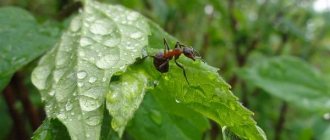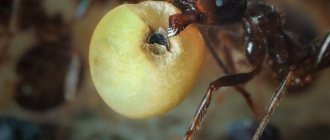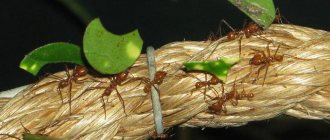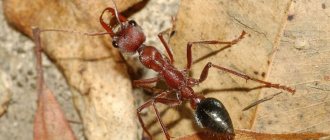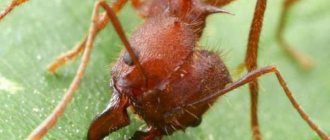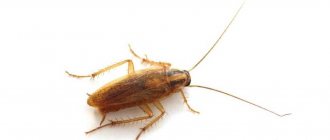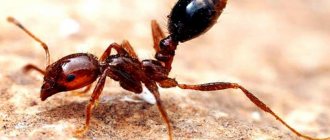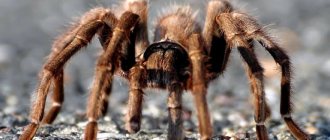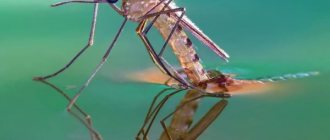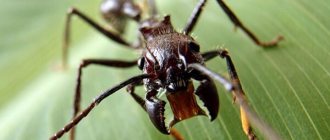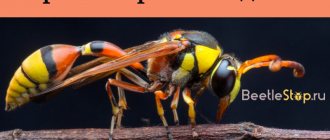Description
Wood ants have a large body, the length of which reaches 1.5 cm. The head is disproportionately large compared to the small chest. Long antennae necessary for touch are localized on it. The males of these insects are visually very different from the females.
Male wood ants have a darker body and red or yellow legs . In addition, they have wings. Female forest representatives have a smaller body of a red-brown color.
They only have wings during the mating season, and then they chew them off. Working individuals are also red-brown and without wings.
Ant larvae have an elongated, large, white body, covered with hairs. During molting, they turn into pupae. To leave the pupa, insects are helped by workers. They break the cocoon, and the young wood ant becomes a full-fledged member of the community.
Peculiarities
The red forest ant has the following features:
- The insect's abdomen has a gland filled with a toxic substance. Forest dwellers use it to protect themselves from enemies. The poison is very painful. Even people feel discomfort from it. And with multiple bites, an allergic reaction can be provoked.
- Wood ants are completely deprived of the organ of hearing, so they do not hear anything. In contrast to this, they have a well-developed sense of smell. Thanks to him, these forest inhabitants can freely navigate the terrain and find prey.
- The organ of vision in forest ants does not work at full capacity. They see, but only violet shades.
- The insect has powerful jaws. Their mouthparts perform several tasks at once: construction, defense, and grasping prey. And also with their help, insects carry eggs and larvae.
Working individuals of red forest ants live 5-6 years, and queens live up to 20 years.
Why are red ants dangerous?
In addition to the described examples of harm caused by the pharaohs, there are other consequences of human proximity to insects:
- On their paws, ants carry dangerous microbes that can cause various diseases - diphtheria, dysentery, typhoid, salmonellosis, cholera.
Ants carry dangerous bacteria on their feet - They are also dangerous for domestic animals, because they are carriers of canine distemper. But the list of consequences of proximity to ants for humans does not end there.
- Insects damage wooden furniture by digging tunnels in it to reach their nests.
- They can cause short circuits in household appliances, because they like to inhabit microwave ovens, televisions, and washing machines.
Unlike their forest counterparts, house ants, due to their modest size, do not have strong mandibles (jaws) capable of opening to such a size as to capture a piece of skin. But there are known cases where they have bitten newborn children, causing itching, pain and allergic reactions.
Ants can bite small children, causing allergic reactions and itching
Varieties
Red forest ants have the following classification:
- Small or forest bareback. Its body length is 7-14 mm, color is red-brown. Found in the temperate zone of northern Eurasia. They create large anthills from needles and twigs (up to 2 m in height).
- Northern forest. Found in temperate forests of Eurasia. Listed on the red list of threatened species.
- Hairy forest. The length of working ants is 4-9 mm, and females and males reach 9-11 mm. They are also listed in the Red Book.
In addition, there are blood ants and black-brown wood ants.
Family life
The process of internal decay never stops. Due to this, a zone with high temperature and humidity is formed inside the house. Larvae, eggs and pupae are stored here. Here is also the home of the most important figure in the anthill - the queen, who lays eggs, which are then looked after by nannies.
Each house has one queen ant. Sometimes it happens that a young female turns one of the summer nests into an independent anthill. At the same time, it takes away some of the working ants with it, since it cannot exist on its own. This creates a completely new house with its own inhabitants.
If the size of the family is large enough, then the queen ant can become another queen. But this happens very rarely. In any case, even the largest anthills cannot have more than two queens.
A situation is also possible when the female becomes the queen in a nest left without a queen. However, this phenomenon happens very rarely; as a rule, it is difficult to find an ownerless anthill in the forest.
Lifestyle
The small forest ant is often found in deciduous, coniferous or mixed forests that have existed for 20-30 years. In the summer, insects are very active, and in the winter they hibernate underground. Forest representatives, like all other species of these insects, are very hardworking.
Forest ants create colonies that live in anthills-nests. They build them in the ground, wood or under stones. Forest insects are well organized. All members of the family have clearly assigned responsibilities.
Forest ants are divided into several castes:
- Females (queens or queens). Representatives of the female species lay eggs. From them, male representatives of the family emerge (from eggs that were not fertilized) and female individuals (from eggs that were fertilized). The body of the queen is noticeably larger than that of males and worker ants. The only long-lived person in the colony is the queen.
- Males. The task of male ants is to participate in mating. After a while, they are destroyed by other relatives from the anthill. Males are smaller than females. They have wings, but they only live 2-3 weeks.
- Foragers (working individuals). These are female representatives whose reproductive system is underdeveloped. They build an anthill and care for their offspring. Their size is significantly smaller than the uterus. They don't have wings.
- Soldier ants. These working members of the family have a large head and highly developed jaws. They duplicate the duties of worker ants and also protect their nest from enemy invasions.
The female mates only once in her life. The resulting male material is enough for her to produce offspring throughout her life (10-20 years).
Architectural structure of the nest
An anthill in the forest is visible from afar. The house of these insects reaches 2 m in height. But this is only the top floor, where forest red ants live in the warm season. The anthill continues up to 3 m deep. There are chambers for storing supplies for the winter and sleeping places.
Anthill of red ants
To build the upper floor, ants use twigs, sticks, leaves, moss, needles, and soil. Initially, it seems that everything is scattered randomly, but this is not so. The conical shape of the house protects the chamber from getting wet during heavy rains, and also ensures the retention of moisture inside during dry periods.
Nutrition
The small forest ant eats absolutely everything. Any insects and their larvae are the basis of the diet of forest ants. Therefore, all trees that grow next to the anthill are reliably protected from pests. In addition, ants love plant sap, as well as the sugary secretions of aphids.
The food suppliers in the anthill are the older workers . More aggressive members of the family engage in hunting. When attacking a victim, the ant paralyzes it with a special acid.
Then he drags the immobilized victim into the anthill. There it is divided into pieces and distributed among adult relatives and individuals.
A hungry relative can get food by tapping his antennae on the forager's head. He will immediately give him a small portion of food. Having satisfied his hunger, he takes the rest of the food deep into the nest, where he feeds other ants, as well as their larvae.
If the forager breaks the rules and does not bring food to the anthill or does not want to share, then they do not stand on ceremony with him for a long time and eat them.
Among the workers there are nannies who care for eggs, larvae and nymphs. They deserve a good portion of food. They spend a lot of effort dragging their offspring from chamber to chamber in order to provide them with suitable development conditions according to age characteristics. Wood ants also collect the sweetish secretions of aphids. In one season they manage to prepare up to 20 kg of such food.
Little worker
We all watch in surprise and admiration as a tiny ant drags prey into its house, many times larger than itself. Everyone will envy their hard work and endurance. What is the role of ants in nature?
Beneficial activities of ants
Unexplored paths of little workers
How are ants useful? These insects are associated with a secret society. For millions of years, exchanging an encrypted language, they pave paths unknown to anyone. We are just beginning to know them today. At first glance, the activities of ants seem chaotic and useless. But is it? What benefits do ants bring to the forest and people?
Tiny soil formers
In the process of building their nests, ants loosen the soil, providing more air access to the roots of plants. But this favors their breathing.
This is especially necessary in places where there are heavy clay soil layers.
For example, an earthworm is active up to 20 cm deep, and a garden ant builds an underground house up to one and a half meters deep in 2-3 years with excellent aeration and humidity of more than 90%.
It is reliably known that thanks to the activity of these insects, the amount of potassium in the soil doubles, and phosphorus becomes ten times more. At the same time, it is they who promote the transition of these substances from an insoluble state to a soluble state available for plant nutrition.
Moreover, these insects enrich the soil with substances such as humus, potassium, nitrogen, improving its structure and increasing fertility.
The benefits of ants in seed dispersal
Small seed spreaders
Ants don't just make trails in search of food and building material for their castles. The ant crawls usefully. Do you know what benefits they have in expanding the flora? About 1% of plants, which is approximately 3,000 species, are spread by these insects.
Celandine, hairy gooseberry, goose onion, thyme, corydalis and many others are equipped with special appendages on their seeds that ants love to feast on. Carrying this delicacy home, they spread the seeds several tens of meters around. By the way, only ants spread fragrant violets.
Ant - forest orderly
By destroying dead insects, ants can rightfully be called nurse insects.
In the forest where anthills are located, there are no outbreaks of mass reproduction of insect pests: sawflies, spider mites, cutworms, slugs.
A medium-sized garden anthill can collect up to 2,000 larvae, eggs, caterpillars and other pests in one day. During the same period, the inhabitants of one forest anthill are able to eat more than 17,000 insects, protecting an area of 0.2 hectares.
Nebaiduzha detail of a forest landscape
Murakhi are forest nurses. It’s not for nothing that they are called that. The creepiness in the forest is on a global scale. Instantly following various kinds of larvae on the trees of the goosebump, the stinkers steal the forest from their massive reproduction.
In addition, the goosebumps affected by the disease do not disappear from the goosebumps, but die on their own.
Ant hydrometeorological center
Another feature that can be usefully used by people and borrowed from these insects is the ability to anticipate weather changes. They feel the storm. The day before they go into the anthill and close all the passages.
Ants as prey
The importance of ants in nature is not limited to their activities. They can benefit by sacrificing themselves. What are ants for?
Nutritious food for birds
Ants are food for forest dwellers
Ants are an important link in the food chain. They are a favorite treat for songbirds, badgers
Bears, foxes, black grouse, and hazel grouse feed on them.
Birds “bathe” in anthills, launching insects under their wings and crushing them on their feathers. In this way they eliminate parasites, and, possibly, are cured with formic acid.
Medicine for humans
Modern medical research has proven that many ailments can be prevented by eating ants for a long period of time.
Diseases such as atrophic arthritis, chronic hepatitis, neurosis, insomnia, even dizziness in older people are treated or alleviated by taking these insects.
Why are ants almost a panacea for these ailments? All thanks to proteins and microelements, which ants are rich in. They also contain a considerable amount of formic acid, used in medicine as a stimulant and astringent.
Reproduction
New male and female individuals from the eggs laid by the uterus are born in the spring. On a warm day after rain, females and males with wings leave the nest.
Having flown 30-40 meters from the anthill, they land and begin mating. After this, the female bites off her wings, forms a new colony or returns to her previous home.
After intercourse, all male ants die. The new queen lays 10 eggs every day . And the workers take care of the offspring. Nymphs produce a special liquid that forms thin webs when exposed to air. Cocoons are spun from them. After 1.5 months, a young forest ant appears.
Young insects have a soft body, a light red chest, and a gray head and chest. After 2-3 days, the chitinous cover gradually hardens, and the ant acquires the color of an adult. At this stage, the teenager loses the guardianship of his older relatives and begins to work on an equal basis with everyone else.
The queen controls her colony, and the ants recognize each other thanks to special pheromones. When forest ants from different colonies meet, it is difficult to avoid a fight.
Aliens bite each other and spray formic acid. They also attract their relatives to help. There are even massive battles that last 2-3 days in a row.
First aid for a “monster” bite
At the first suspicion of a dangerous insect bite, you should quickly move away from the place where the source of fire ants is located
This must be done carefully so as not to cause unrest in the “family.” Usually, guard animals are the first to bite.
You won’t be able to shake off the insects, which means you need to carefully remove them from clothing and parts of the body. They cannot be crushed, because crushed ants emit a smell, through which other members of the family receive a signal of danger and immediately begin a new attack. After this, you need to free the affected area of skin from clothing in order to reduce swelling. Rinse the area, then place a cold compress on it. Be sure to take an antihistamine. Then seek help from a medical facility. Delay can be costly because the venom is a strong allergen that often causes pulmonary edema.
Benefits and harms
Wood ants are useful in such areas:
- The formic alcohol secreted by these insects is used for medicinal purposes.
- Ant passages are beneficial for the soil - through them it is enriched with oxygen.
- An insect colony prevents pests from multiplying excessively.
The bites of these insects are dangerous for humans. Formic acid causes swelling, itching, headache and disturbance of spatial orientation. In allergy sufferers, this substance provokes anaphylactic shock.
In addition, if a forest ant lives close to a person, then the garden will suffer from an invasion of aphids, which the ants grow.
Yet these forest insects are important to the balance of the ecosystem. People should remember this when they have a desire to stir up or destroy an ant house out of curiosity.
Little worker
We all watch in surprise and admiration as a tiny ant drags prey into its house, many times larger than itself. Everyone will envy their hard work and endurance. What is the role of ants in nature?
Beneficial activities of ants
Unexplored paths of little workers
How are ants useful? These insects are associated with a secret society. For millions of years, exchanging an encrypted language, they pave paths unknown to anyone. We are just beginning to know them today. At first glance, the activities of ants seem chaotic and useless. But is it? What benefits do ants bring to the forest and people?
Tiny soil formers
In the process of building their nests, ants loosen the soil, providing more air access to the roots of plants. But this favors their breathing.
This is especially necessary in places where there are heavy clay soil layers.
For example, an earthworm is active up to 20 cm deep, and a garden ant builds an underground house up to one and a half meters deep in 2-3 years with excellent aeration and humidity of more than 90%.
It is reliably known that thanks to the activity of these insects, the amount of potassium in the soil doubles, and phosphorus becomes ten times more. At the same time, it is they who promote the transition of these substances from an insoluble state to a soluble state available for plant nutrition.
Moreover, these insects enrich the soil with substances such as humus, potassium, nitrogen, improving its structure and increasing fertility.
The benefits of ants in seed dispersal
Small seed spreaders
Ants don't just make trails in search of food and building material for their castles. The ant crawls usefully. Do you know what benefits they have in expanding the flora? About 1% of plants, which is approximately 3,000 species, are spread by these insects.
Celandine, hairy gooseberry, goose onion, thyme, corydalis and many others are equipped with special appendages on their seeds that ants love to feast on. Carrying this delicacy home, they spread the seeds several tens of meters around. By the way, only ants spread fragrant violets.
Ant - forest orderly
By destroying dead insects, ants can rightfully be called nurse insects.
In the forest where anthills are located, there are no outbreaks of mass reproduction of insect pests: sawflies, spider mites, cutworms, slugs.
A medium-sized garden anthill can collect up to 2,000 larvae, eggs, caterpillars and other pests in one day. During the same period, the inhabitants of one forest anthill are able to eat more than 17,000 insects, protecting an area of 0.2 hectares.
Nebaiduzha detail of a forest landscape
Murakhi are forest nurses. It’s not for nothing that they are called that. The creepiness in the forest is on a global scale. Instantly following various kinds of larvae on the trees of the goosebump, the stinkers steal the forest from their massive reproduction.
In addition, the goosebumps affected by the disease do not disappear from the goosebumps, but die on their own.
Ant hydrometeorological center
Another feature that can be usefully used by people and borrowed from these insects is the ability to anticipate weather changes. They feel the storm. The day before they go into the anthill and close all the passages.
Ants as prey
The importance of ants in nature is not limited to their activities. They can benefit by sacrificing themselves. What are ants for?
Nutritious food for birds
Ants are food for forest dwellers
Ants are an important link in the food chain. They are a favorite treat for songbirds, badgers
Bears, foxes, black grouse, and hazel grouse feed on them.
Birds “bathe” in anthills, launching insects under their wings and crushing them on their feathers. In this way they eliminate parasites, and, possibly, are cured with formic acid.
Medicine for humans
Modern medical research has proven that many ailments can be prevented by eating ants for a long period of time.
Diseases such as atrophic arthritis, chronic hepatitis, neurosis, insomnia, even dizziness in older people are treated or alleviated by taking these insects.
Why are ants almost a panacea for these ailments? All thanks to proteins and microelements, which ants are rich in. They also contain a considerable amount of formic acid, used in medicine as a stimulant and astringent.
